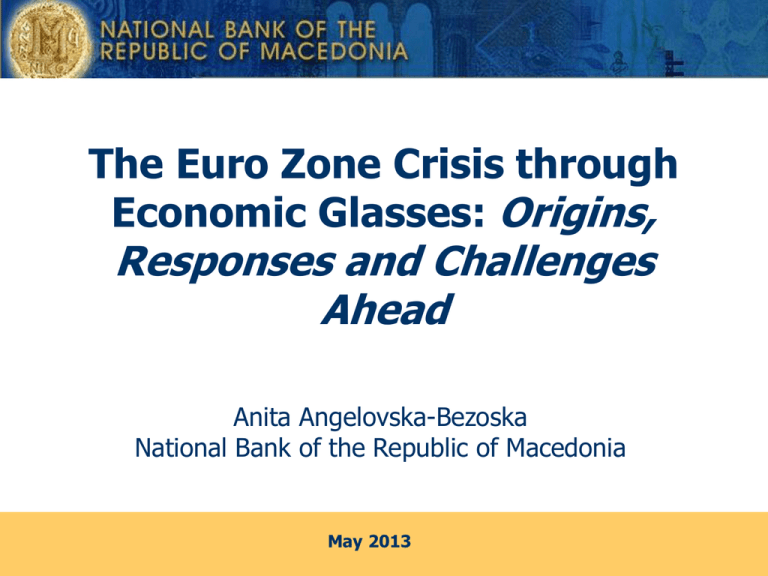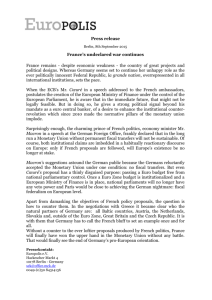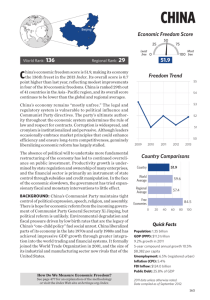Forecasting outstanding debt securities in Europe
advertisement

The Euro Zone Crisis through Economic Glasses: Origins, Responses and Challenges Ahead Anita Angelovska-Bezoska National Bank of the Republic of Macedonia May 2013 NBRMNBRMNBRMNational Bank of the Republic of MacedoniaNBRMNBRMNBRM Content What are the origins and implications of the Euro zone crisis? How are European policymakers dealing with it? What are the main challenges ahead? NBRMNBRMNBRMNational Bank of the Republic of MacedoniaNBRMNBRMNBRM US financial crisis as a trigger of the EU banking system disruptions European banks were heavily affected by the global financial crisis... Direct effects – strong negative effects on the European financial institutions that held many “toxic” assets originating from the United States. Preexisting conditions contributed as well – high credit growth accompanied with high leverage and low equity ratios implied high vulnerability NBRMNBRMNBRMNational Bank of the Republic of MacedoniaNBRMNBRMNBRM The financial turmoil brought to the fore the intrinsic deficiencies of the Euro zone The process of intra EU financial integration turned into process of financial fragmentation (sharp reversal of capital flows from periphery to the core) The risk premium of the periphery increased...the growth-interest rate differential turned sharply –the risk of insolvency become a reality The banking system faced with funding pressures – the deleveraging, as well as the renationalization of banks BIS cross-border bank claims (in percent of reporting country’s GDP) Source: IMF Staff Discussion Note 13/01. NBRMNBRMNBRMNational Bank of the Republic of MacedoniaNBRMNBRMNBRM Banking crisis paralyzed the economic activity Resulting halt in the credit flows, as a key source for financing the corporate sector, contributed to... contraction of economic activity... ...and rise in unemployment GDP growth rate (in %) 8.0 25 6.0 20 4.0 2.0 UNEMPLOYMENT RATE (3 year backward moving average) Germany Ireland Spain Portugal France Greece Italy 15 0.0 10 -2.0 -4.0 -6.0 EA 17 Ireland Portugal Greece Italy Spain 5 0 -8.0 2003 2004 2005 2006 2007 2008 2009 2010 2011 2012 Source: Eurostat, Macroeconomic Imbalance Procedure. NBRMNBRMNBRMNational Bank of the Republic of MacedoniaNBRMNBRMNBRM Financial and economic crisis emerged into sovereign debt crisis Financial assistance to the banking system, automatic stabilizers and discretionary countercyclical policies lead to an increase in the government deficits and the level of public debt across the Euro zone... ...in some countries even to unsustainable levels.... ...questioning the solvency of the public finances Government deficit (% of GDP) 5.0 180 160 0.0 140 -5.0 GENERAL GOVERNMENT DEBT (in % of GDP) Germany Ireland Spain Portugal France Greece Italy 120 -10.0 100 -15.0 80 -20.0 60 -25.0 -30.0 EA 17 Ireland Portugal Greece Italy Spain 40 20 0 -35.0 2003 2004 2005 2006 2007 2008 2009 2010 2011 2012 Source: Eurostat, Macroeconomic Imbalance Procedure. NBRMNBRMNBRMNational Bank of the Republic of MacedoniaNBRMNBRMNBRM Pre-crisis fundamentals shaping the severity of impact Peripheral EU countries with higher macro-economic imbalances in the pre-crisis period suffered more... The build-up of imbalances was supported by the easy access to finance and convergence of nominal interest rates as a result of the interest rate convergence across the Euro zone in the early 90s, despite different fundamentals of different countries NBRMNBRMNBRMNational Bank of the Republic of MacedoniaNBRMNBRMNBRM Pre-crisis fundamentals shaping the severity of impact Some of the countries enjoyed consumption-driven growth, fueled by abundant inflows in non-tradable sector, which lead to rising unit labor costs, current account deficits and indebtedness of the economy. CURRENT ACCOUNT BALANCE (as % of GDP, 3 year backward moving average) NOMINAL UNIT LABOUR COST (3 years percentage change) 20 15 10 10 5 Germany Ireland Spain Portugal France Greece Italy France Greece Italy 150 -5 -15 250 Germany Ireland Spain Portugal 0 0 -10 300 200 5 -5 350 PRIVATE SECTOR DEBT (in % of GDP) Germany Ireland Spain Portugal France Greece Italy Source: Eurostat, Macroeconomic Imbalance Procedure. 100 -10 50 -15 0 Source: Eurostat, Macroeconomic Imbalance Procedure. Source: Eurostat, Macroeconomic Imbalance Procedure. NBRMNBRMNBRMNational Bank of the Republic of MacedoniaNBRMNBRMNBRM The crisis brought to the fore the old debates about the main ingredients of the “monetary union” GENERAL OCA CRITERIA Mobility of factors of production Financial integration Convergence of inflation rates Diversification of production Symmetry of external shocks Openness of the economy How close was EUROZONE to OCA before crisis? Capital mobility Labour mobility Financial integration Convergence of inflation rates Fiscal integration Many OCA criteria remain unfulfilled implying still diverse economies. NBRMNBRMNBRMNational Bank of the Republic of MacedoniaNBRMNBRMNBRM The crisis brought to the fore the old debates about the main ingredients of the “monetary union” Many OCA criteria remain unfulfilled implying still diverse economies. The crisis showed that a combination of diverse economies with single currency in not sustainable. In addition, it confirmed the view of German “economists” (50 years ago) that monetary union should come after economic and political union is reached (as opposed to French “monetarists” view that monetary union should lead to economic and political union). Current policy set-up: centralized monetary policy and decentralized other policies can lead to build up of macroeconomic imbalances endangering the financial stability of the EA. In particular when the mechanisms aimed at ensuring consistent macroeconomic policies do not work (SGP) NBRMNBRMNBRMNational Bank of the Republic of MacedoniaNBRMNBRMNBRM (Non)Compliance with the fiscal Maastricht criteria by Euro zone members) NBRMNBRMNBRMNational Bank of the Republic of MacedoniaNBRMNBRMNBRM Policy Responses to Contain the Euro Zone Crisis • The ECB played an important role in containing the crisis... ECB • Lowering policy rate and RR requirement • Liquidity provision to banks at longer tenures • Expansion of the collateral framework • Covered bond purchase program • Securities market program: purchase of state securities • Outright monetary transactions: unlimited government bond purchases with conditionality to apply to ESM •The undertaken measures addressed the “acute” issues of liquidity and calming market expectations ... • While additional measures introduced to tackle “design failures” of the monetary union NBRMNBRMNBRMNational Bank of the Republic of MacedoniaNBRMNBRMNBRM Policy Responses to Contain the Euro Zone Crisis The sovereign debt crisis exposed fundamental weaknesses in the EU’s economic governance framework... ...filling the gaps by moving towards the fiscal and financial union “too much monetary union and ... ...too little fiscal union” in the Euro zone NBRMNBRMNBRMNational Bank of the Republic of MacedoniaNBRMNBRMNBRM Policy responses to address “design failures” The reforms of the European legislation aimed at addressing the “design failures”: Strengthening economic coordination, through: policy prevention and correction macroeconomic imbalances (MIP); policy reform plans to be discussed ex-ante with special focus on convergence and competitiveness. Fostering fiscal discipline, through: stricter budget rules; automatic application of corrective mechanism; emphasis on the preventive stage; more strict application of the correction of excessive debt ratios in MS. SIX-PACK (December 2011) The six-pack reinforces the SGP both in the preventive and in the corrective arm of the Pact, i.e. the Excessive Deficit Procedure (EDP), which applies to Member States that have breached either the deficit of the debt criterion. Treaty on Stability, Coordination, and Governance ( March, 2012) FISCAL COMPACT (March, 2012) The Fiscal Compact, which is the fiscal part of the Treaty on Stability, Coordination and Governance (TSCG)- runs in parallel with the six-pack. TWO-PACK (expected by the summer 2013) The proposed regulation for ”monitoring and assessing draft budgetary plans and ensuring the correction of excessive deficit of the Member States in the Euro area” aims at further strengthening the budgetary and economic surveillance of the Euro area countries and restoring confidence in financial markets. Fostering greater banking integration, through: enhanced supervisory coordination; and uniform supervisory-regulatory framework NBRMNBRMNBRMNational Bank of the Republic of MacedoniaNBRMNBRMNBRM The Six Pack Stricter fiscal surveillance and application of fiscal rules by: defining quantitatively “significant deviation from the MTO”; making SGP debt criterion more operational, i.e., allowing EDP procedure, even if the deficit is below 3%, when debt is above 60%; Imposing financial sanctions in a gradual way throughout the EDP (0,5% of GDP); introducing reverse qualified majority voting for most of the sanctions. Stricter macroeconomic surveillance through MIP. In 2012, 23 of 27 member states were in EDP (except for Estonia, Finland, Luxembourg and Sweden) NBRMNBRMNBRMNational Bank of the Republic of MacedoniaNBRMNBRMNBRM The Fiscal Compact: Treaty on Stability, Coordination and Governance (TSCG) Treaty applicable to euro zone member states only (UK and Czech republic will not adopt it) Common budgetary rules at the national level- balanced budget rule Structural deficit not to exceed 0.5% of GDP If MS deviates, automatic correction mechanism will be triggered “Balanced budget rule” enshrined in the national law, preferable at constitutional level Compliance also monitored by independent national institutions NBRMNBRMNBRMNational Bank of the Republic of MacedoniaNBRMNBRMNBRM European Stability Mechanism From temporary EFSM and EFSF to a permanent resolution mechanism – “a firewall against debt crisis” Provide loans to a euro zone member state in financial difficulties; Intervene in the primary and secondary debt markets; Precautionary credit lines; Provide loans to governments for the purpose of recapitalization of financial institutions. Permanent facility, providing conditional financing, defending the sovereign and financial stability NBRMNBRMNBRMNational Bank of the Republic of MacedoniaNBRMNBRMNBRM European banking union – SSM is a first steps on a long march Motivation: Integrated banking system requires integrated prudential oversight. EMU system of unity in monetary policy, but national plurality in financial policies showed to be unsustainable. Goal: safeguard of financial stability through: reducing fragmentation of financial markets; weaken the loop of sovereign and bank borrowing costs; and thus, enhance the monetary policy transmission mechanism. NBRMNBRMNBRMNational Bank of the Republic of MacedoniaNBRMNBRMNBRM Financial Fragmentation Diverging funding costs deviating from the policy rate path Sovereign creditworthiness affecting that of banks Source: IMF Staff Discussion Note 13/01. ...and acknowledging the doom loop NBRMNBRMNBRMNational Bank of the Republic of MacedoniaNBRMNBRMNBRM European banking union - first steps on a long march EUROPEAN BANKING UNION 1. Single Supervisory Mechanism (SSM) - Supervisory tasks and powers to ECB -Separation from monetary policy -Applies to all EA MSs, open for non-EA MSs 2. Single Resolution Mechanism (SRM) and Backstops -For individual bank failures 3. European Deposit Insurance Scheme -Intended to tackle the problem of capital flight -Financed by industry on a riskbased approach - Appropriate and effective backstop arrangements for systemic cases Status: pending Adoption targeted – Q2 2013 -Most of the banking system under direct EU authority (80-85% of the Status: pending system) Status: established in March 2013 Adoption targeted – Q2 2013 Establishment targeted –mid Operational – mid 2014 2014 NBRMNBRMNBRMNational Bank of the Republic of MacedoniaNBRMNBRMNBRM The Euro crisis led to profound governance reforms...but are we there yet? The creation of the ESM supports the overall structure of EMU – but the risks of moral hazard requires stringent observance of macro-conditionality for acquiring financial assistance • The ESM limited financial capacity implies that it cannot be treated as a lender of last resort and prevent panic and self- fulfilling liquidity crisis. Reforms on fiscal governance comprehensive and profound, but... • Room for national administrative and political discretion • Higher complexity in monitoring and implementation of rules • Strict observance, implementation and ownership – key for not replicating the same flaws of the former fiscal set-up • Fully fledged fiscal union? – a lively debate with lots of pros and cons coming to the fore • Strengthening economic policy coordination-prerequisite for preventing macroeconomic imbalances and higher convergence, but TSCG seems “vague” on the implementation instruments. Banking union – indispensable for breaking the banking – sovereign vicious circle. However if left alone, without unified crisis resolution mechanisms and appropriate backstop, the full benefits will not be reaped. NBRMNBRMNBRMNational Bank of the Republic of MacedoniaNBRMNBRMNBRM Future of the Euro zone The bold response of policy makers clearly removed the tail risk of Euro zone break up... ...but the Euro zone must continue fixing structural and institutional deficiencies, which exacerbated the crisis increase wage and labor flexibility move towards more sustainable growth through increasing the overall competiveness of the Euro zone continue with the efforts in enhancing the fiscal, macroeconomic and financial governance • enabling better fiscal discipline and flexibility • providing financial backstops • creating more robust banks and hence lesser risk and less contagion The crisis proved that the smooth functioning of a monetary union requires economic competiveness, fiscal sustainability and stability of the financial system NBRMNBRMNBRMNational Bank of the Republic of MacedoniaNBRMNBRMNBRM







